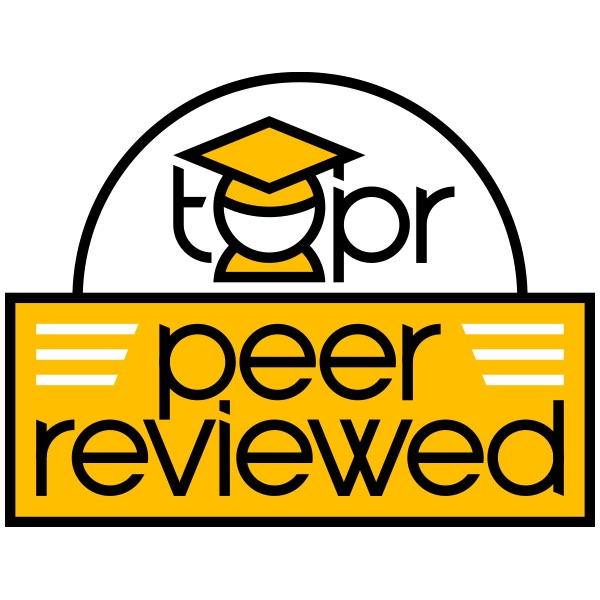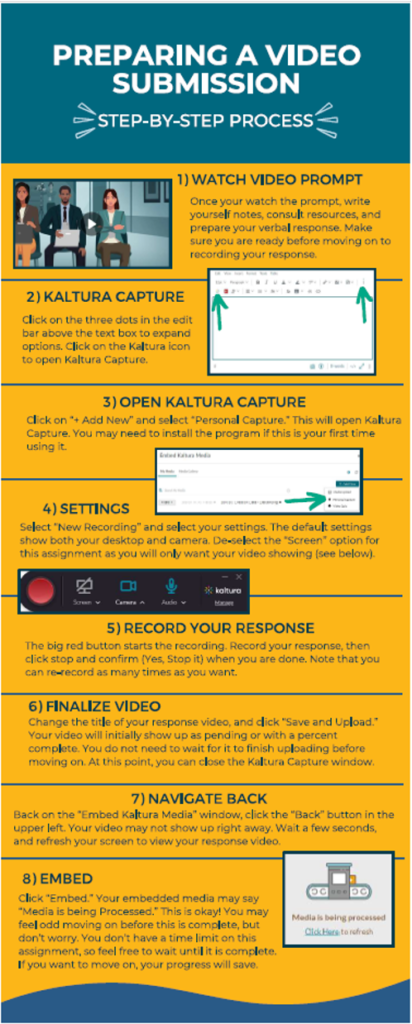
With more higher education experiences moving online, students have fewer opportunities to practice their verbal communication skills compared to traditional face-to-face environments. Speeches, presentations, and recitations that students might engage in within a traditional brick and mortar classroom may be less feasible online, and students also miss out on the typical questioning, conversation, and interaction that occur in person (Rawashdeh et al., 2021). In many fields, verbal communication is a critical skill for professional success. Specifically, in public health which is the field for which this assessment was development, effective communication is one of the core competencies according to the Council for State and Territorial Epidemiologists (2023). Online educators and instructional designers need to find creative ways to help students practice this skill (Tanian & James, 2002).
Within the Canvas LMS, the quiz function can be a way to engage students in this skill. Traditionally, quizzes are designed as text-based prompts with multiple choice options or a field to draft an essay response. Our team took an innovative approach and built multimedia prompts in the quiz tool; students are then required to record their own video responses to each prompt using the Embed Kaltura Media button in the main navigation pane. Students can review and re-record their individual video responses prior to submitting, allowing them to reflect on and practice their verbal communication skills.
Strategy Implementation
This strategy is used within our online Ph.D. in Public Health curriculum in the Epidemiological Investigations course. As doctoral public health professionals, students will undoubtedly be faced with biased and inaccurate information about health-related topics. This assignment asks students to imagine that they are participating in a press conference and responding to questions from news reporters that could be potentially biased. Students must respond to any type of question in a professional and evidence-based manner.

The assessment is set up as a Canvas quiz with 5 different prompts. Working together with a subject matter expert and educational media specialist, we constructed a scenario depicting a press conference. Various questions were drafted and recorded as video animations. The first prompt is a video animation that depicts what would be considered the student’s boss at their imagined health department job. She explains that their health department was asked to participate in this press conference and that she would like the student to respond to the press because of their expertise in this area. She also explains that multiple news organizations are invited, and that several are known to be biased. Her instructions are to be professional and support all responses with facts and evidence. Her final question asks, “Are you ready to begin?” When the student selects “yes,” they move on to the three content-based video prompts.

The next three items in the assessment depict the press conference where news reporters are gathered from various outlets. The questions cover somewhat controversial topics related to the COVID-19 pandemic like isolation, face masks, inequities, variants, transmission, and vaccines. Each student receives one conservatively biased question, one liberally biased question, and one neutral question. For each animated video question, the scene starts in a large room full of diverse individuals, presumably news reporters. The video zooms in on one reporter who poses a question.

Examples of conservatively biased questions include:
I have heard COVID is no worse than the flu. Is this true?
The CDC keeps changing their minds about when we should wear a mask. How are we supposed to trust them?
Examples of liberally biased questions include:
COVID-related hospitalizations and deaths are highest in the southern U.S. Is this related to low vaccination rates?
How long can COVID stay on surfaces? Should we be worried about virus particles on take-out food or groceries?
Examples of neutral questions include:
How is COVID transmitted?
How can we address COVID misinformation?

Below each video question, students are provided with the open text field, and they are asked to record a video response to the question. Because the process of recording and embedding a video response involves several steps, the development team created an instructional infographic that is included with each prompt explaining the steps needed to record, embed, and submit their videos responding to the questions. As students move through the video prompts, they are permitted to re-record their responses as many times as needed. When they are satisfied with each of their three recorded responses, they move to the final question in the Canvas quiz.
To complete this assessment, students are asked to reflect on their experience in responding to these questions from the press. For the final question in the quiz, they are returned to the boss character who asks how the press conference went. This is accompanied by a text-based prompt that asks students to consider what they did well, what they could have done better, their strengths, their weaknesses, and the level of rigor they felt this assessment required. Students have the option of completing their reflection either in text or with another video recording.
Through this activity, students are given a chance to verbally communicate information to a non-scientific audience, a critical skill in public health practice and one that faculty and administrators are constantly working to cultivate within students.
Using the Canvas Quiz tool for practicing communication skills can be applicable in almost every discipline. For example, teacher candidates in an BS in Elementary Education program could build their communication skills in a simulated parent-teacher conference where they record and practice their responses to a parent or guardian’s questions about their child, a particular teaching approach, or a school policy. Example video prompt questions for this scenario could include:
When Erick brings homework home, we have such a hard time getting him to finish it without him dissolving into tears. Do you have any strategies you could share for helping him through his work?
We got an email last week from the school’s principal about the new “no homework” policy that is supposedly district wide. We aren’t sure that is going to teach them good time management or give them enough time to really learn the topics. Can you explain how the district came to this decision?
Similarly, MBA students might address a leadership and/or communication issue by recording their responses to a scenario depicting employees who are asking questions about organizational change. Example questions for this scenario include:
I wanted to gain some clarity around the email you sent yesterday. In it, you said that the policy change around PTO would go into effect immediately. Will this new policy affect existing accrued leave balances?
We have been made aware of the new dress code policy and had some questions that were not addressed in the communication. Will exceptions be made for people in certain roles or for special occasions?
Finally, there is a potential application for this type of quiz format across disciplines as a professional development exercise. The video prompt/video response format could be used to simulation a job interview in any discipline. Example questions for this scenario include:
What interests you about the field of [add discipline]?
Describe your background, skills, and experiences that make you a good fit for this role?
Because communication is such an important professional skill, this strategy has endless possibilities to support student success.

Scholarly References
Al Rawashdeh, A. Z., Mohammed, E. Y., Al Arab, A. R., Alara, M., & Al-Rawashdeh, B. (2021). Advantages and disadvantages of using e-learning in university education: Analyzing students’ perspectives. The Electronic Journal of e-Learning, 19(2), 107-117. https://doi.org/10.34190/ejel.19.3.2168
Council for State and Territorial Epidemiologists. (2023). Workforce: Competencies. https://www.cste.org/group/CSTECDCAEC
Tanian, S., & James, K. (2002). Could oral communication skills become a casualty of online learning? A future scenario that could prevent this. Research and Development in Higher Education: Quality Conversations, 25. https://ro.ecu.edu.au/ecuworks/3749/
Citation
McLaughlin, A., Lawlor, M., Strang, K., Ferraro, A. (2024). Adapting the Canvas Quiz to Practice Verbal Communication. In deNoyelles, A., Bauer, S., & Wyatt, S. (Eds.), Teaching Online Pedagogical Repository. Orlando, FL: University of Central Florida Center for Distributed Learning.